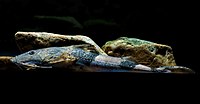
Photo from wikipedia
Four new species of Rhinogobius Gill 1859 are described from the Black River drainage in China and Vietnam. Rhinogobius coccinella, new species, and R. nanophyllum, new species, are described from… Click to show full abstract
Four new species of Rhinogobius Gill 1859 are described from the Black River drainage in China and Vietnam. Rhinogobius coccinella, new species, and R. nanophyllum, new species, are described from the Mengyejiang River in Yunnan, China. Rhinogobius coccinella is diagnosed by having the cheek and operculum with about 25 large dark spots and branchiostegal membrane unmarked; caudal-peduncle depth 11-12% SL; 1-5 predorsal scales; 27-30 midlateral scales; and 28 vertebrae. Rhinogobius nanophyllum is diagnosed by having the cheek, operculum and pectoral-fin base with about 90 indistinct white marks, caudal fin plain-colored, second dorsal fin magnified with a very broad dark gray median band and a broad white proximal band in males; caudal-peduncle length 22-25% SL and pectoral-fin length 21-24% SL in males; head width at operculum 53-58% HL in males, 58-61% HL in females; 0 predorsal scales; 8-10 branched rays in the second dorsal fin; 7-8 branched anal-fin rays; and 28 vertebrae. Rhinogobius ngutinhoceps, new species, is described from the Nam Na River in Lai Chau, Vietnam. It differs from all congeners by the presence of a supraotic pore β; cheek and operculum with about 65 dark marks and branchiostegal membrane unmarked in males; snout pointed; lower jaw conspicuously protruding; predorsal length 40-41% SL; 12-15 predorsal scales; and 29 vertebrae. Rhinogobius phuongae, new species, is described from the Nam Mu River in Lai Chau, Vietnam, and is diagnosed by having the cheek with about 25 indistinct dark spots and branchiostegal membrane with pale spots in males; operculum unmarked; flank plain-colored in males; a conspicuous black blotch between spines I and III of the first dorsal fin; unpaired fins with a very broad white distal band; pectoral-fin length 20-21% SL; 8-10 predorsal scales; 8-9 branched rays in the second dorsal fin; and 28 vertebrae. A key to the species of Rhinogobius occurring within the Red River drainage is given.
Journal Title: Zootaxa
Year Published: 2018
Link to full text (if available)
Share on Social Media: Sign Up to like & get
recommendations!